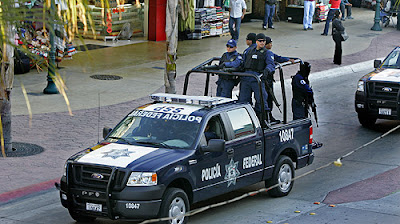Don Bartletti /
A convoy of heavily-armed federal police roll along Avenida Revolucion. Since January 1st this year, more than 2-dozen people have been killed across the city.
The one-time party mecca is a ghost of its former self. But merchants say beautification efforts and police crackdowns have left downtown safer and spiffier than in years.
By Richard Marosi,
February 17, 2008
But empty bars and shuttered businesses now outnumber people mingling near the broken fountain. Rojas, who earns tips by making a show of slamming tequila shots on the table and pouring them down customers’ throats, says it’s been a week since he performed one of his signature tricks, twirling a tourist on his shoulders.
“Look around, it’s dead,” he said.
In the sleepy plaza, down the lonely pedestrian promenade leading to the heart of the tourist district on Avenida Revolucion, bored waiters and strip club hawkers compete for the trickle of customers, while old-time merchants wax nostalgic about the days when a downtown dotted with attractions drew millions of visitors, including the occasional Hollywood star.
Visits are down 90% since 2005, when an estimated 4.5 million came to the area, according to the downtown merchants association. On an average day now, only about 150 tourists show up, the association says. Some encounter the latest
Grant Bourne, a 23-year-old tourist from
The odd sight of soldiers next to the mariachi-filled Plaza Santa Cecilia enriched his visit in a culture-clash sort of way, he said, and the military presence certainly made him feel safe. But he planned to stay downtown, he said, because “I was told not to stray too far off this street.”
The tourism collapse is especially sad, many merchants and tourists say, because people may not be aware that recent beautification projects and police crackdowns have left the area safer and spiffier than it has been in years.
Tree-lined promenades feature repaved sidewalks and roadways. Police sweeps have cleared out the drug addicts. Gone too are most of the beggars and hookers. At the balcony bars, club owners have turned down the ear-splitting volume.
Many stores showcase high-quality products: silver from
“That’s what really represents downtown
Still, they acknowledge, that’s not what
Since Jan. 1, more than 50 people have been killed across the city, some in wild shootouts that terrified bystanders. Last month, police discovered an organized-crime hide-out near downtown that they said included a training center for hit men complete with a soundproofed basement shooting range.
Recently, the upscale restaurant Hacienda Cien Años, which once drew tourists, was identified by
Downtown has been flooded with police and has been largely free of the violence. No bystanders have been killed in the shootouts. A crackdown on corrupt transit cops has resulted in fewer reports of extortion, and merchants immediately report officers who stop tourists without reason, according to police.
Still, the negative image hangs over the city. “In reality, the violence isn’t targeting tourists. It’s between drug traffickers, criminals and police. But the tourist doesn’t know the difference,” said Victor Clark Alfaro, director of
Meanwhile, merchants say even some of those who haven’t been scared off by crime reports may be reluctant to visit because of new, stricter requirements for Americans reentering the
“Americans had 9/11; we had 1/31,” said Rojas, the waiter, referring to the date the new rules went into effect.
Aiming to ease the transition to stricter requirements, Baja California tourism officials recently announced a new program called “Get Your Passport” that offers discounts at certain hotels and restaurants to people with U.S. passports.
In the early days of Tijuana tourism, in the 1920s and 1930s, the economy grew fast by catering to Americans’ appetites for vice, and the city’s tourism fortunes have long risen and fallen with the changing social mores and economy north of the border.
The fabled Agua Caliente casino and racetrack thrived during Prohibition and attracted such
In the postwar era,
Tourist flows peaked in the 1970s, say experts and longtime merchants, but the end of horse racing and the closure of the jai alai arena in the early 1990s started a steady decline. Along Avenida Revolucion, bars and nightclubs offering a warm welcome to underage drinkers opened to take up the slack.
Only glimmers of the past remain.
At the historic Caesar’s Restaurant, which calls itself the “officially certified” home of the Caesar salad, a picture of Paul McCartney sipping a margarita hangs over the bar. A bartender, engrossed in a chess game with the lone customer, dismissed questions about the ex-Beatle’s visit.
Meanwhile, a waiter was busy hanging up a sign on the railing outside — for Caesar’s Men’s Club. At night, the former banquet hall in the back of the restaurant becomes a strip club. “Come by later,” said a waiter. “The lap dances are only $20.”
Farther down Avenida Revolucion, pushy shoeshine boys and loud barkers compete for visitors’ attention, tossing out such lines as “Got a Mexican minute, mister?”
Many bars offer all-you-can-drink deals. Locals pack the Caliente casino, with its 10-cent slots.
Young men urge passersby to saddle up for pictures on the
It was all too much for James Osborne, a 25-year-old visitor from
“We’ve had enough,” Osborne said. “Everybody’s trying to hustle you.”
Keith and Diane Heuser, hospital administration professionals from
The couple and their friends bought a $180 leather jacket and a silver necklace, ate chiles rellenos and drank margaritas.
“We’re having a great time. It’s tacky but entertaining,” said Keith Heuser, while smoking a Cuban cigar on a stroll down lonely Avenida Revolucion.
It used to seem as if
“We never imagined that tourists would stop coming,” said Clark Alfaro of the

